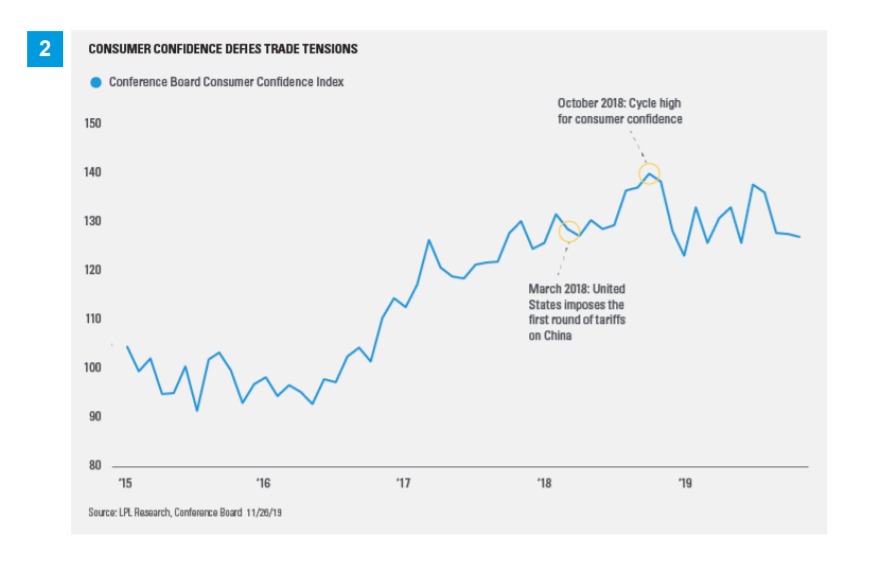ECONOMY:
MODERATING GROWTH AMID TRADE WORRIES
November data reflected moderating growth as the U.S. economy continued to battle trade worries.
The Conference Board’s Leading Economic Index (LEI) rose 0.3% year over year in October, tying its slowest pace of growth since 2016. Even though LEI growth slowed, the gauge was still positive year over year, a good sign for the future of the economic expansion.
Nonfarm payrolls climbed higher than consensus forecasts in October, according to the data released in early November, and September and August payrolls growth were also revised upward. The 12-month average payrolls change through October was slightly higher than the expansion average [Figure 1].
Consumer inflationary pressures looked healthy and manageable. The core Consumer Price Index (CPI), which excludes food and energy prices, climbed 2.3% year over year in October, around a cycle high. Wages, which comprise about 70% of business costs, rose 3% year over year in October, slightly below the cycle high. Still, producer price growth declined. The core Producer Price Index increased 1.6% year over year in October, the slowest pace of growth since February 2017.

Core personal consumption expenditures (PCE), the Federal Reserve’s (Fed) preferred inflation gauge, increased 1.6% year over year in October. Year-over-year core PCE growth remained slightly below the Fed’s 2% growth target.
U.S. manufacturing data improved. The Institute for Supply Management’s (ISM) Purchasing Managers’ Index (PMI) rose in October from a 10-year low but still stayed in contractionary territory (below 50). On the other hand, Markit’s U.S. manufacturing PMI remained just within expansionary territory in November.
Underlying data on the U.S. consumer was mixed. The Conference Board’s Consumer Confidence Index slid for a fourth straight month in November, but the index is still elevated historically [Figure 2].
Retail sales bounced back in October, even though spending fell for a swath of discretionary items.
Business spending accelerated in October. Orders for nondefense capital goods (excluding aircraft) rose month over month at the fastest pace since January. However, capital goods orders declined year over year, showing the long-term trend was still mixed.
More Signals of a Rate Cut Pause
The Fed did not meet in November; however, minutes from the Fed’s October meeting showed an improving economic outlook may be edging out elevated downside risks in policymakers’ decisions. In the minutes, Fed policymakers discussed both dynamics at length, as they have at several meetings this year. The Fed ended up reducing the fed funds rate by 0.25%, citing low inflation and downside risks as reasons to lower the policy rate for a third time this economic cycle.
However, participants agreed to remove the “act as appropriate” language in the post-meeting statement. The change was seen as consistent with the view that current monetary policy was appropriate as long as the U.S. economy performs as expected, and policy could be changed if there is a “material reassessment of the economic outlook.”
The October rate cut also was heavily contested among Fed members. Only two voters dissented, but the minutes showed that a “couple of participants,” who ultimately voted for the cut, thought the decision was a “close call.”

Click here to download a PDF of this report.
IMPORTANT DISCLOSURES
Investing involves risks including possible loss of principal. No investment strategy or risk management technique can guarantee return or eliminate risk in all market environments.
The opinions voiced in this material are for general information only and are not intended to provide specific advice or recommendations for any individual security. To determine which investment(s) may be appropriate for you, consult your financial advisor prior to investing. The economic forecasts set forth in this material may not develop as predicted. All performance referenced is historical and is no guarantee of future results.
All information is believed to be from reliable sources; however LPL Financial makes no representation as to its completeness or accuracy.
For a list of descriptions of the indexes referenced in this publication, please visit our website at lplresearch.com/definitions.
This Research material was prepared by LPL Financial, LLC.
Securities and advisory services offered through LPL Financial (LPL), a registered investment advisor and broker-dealer (member FINRA/SIPC). Insurance products are offered through LPL or its licensed affiliates. To the extent you are receiving investment advice from a separately registered independent investment advisor, please note that LPL is not an affiliate of and makes no representation with respect to such entity.
If your advisor is located at a bank or credit union, please note that the bank/credit union is not registered as a broker-dealer or investment advisor. Registered representatives of LPL may also be employees of the bank/credit union. These products and services are being offered through LPL or its affiliates, which are separate entities from, and not affiliates of, the bank/credit union. Securities and insurance offered through LPL or its affiliates are:
Not FDIC or NCUA/NCUSIF Insured | No Bank or Credit Union Guarantee | May Lose Value | Not Guaranteed by Any Government Agency | Not a Bank/Credit Union Deposit
Tracking # 1-925867 (Exp. 12/20)
